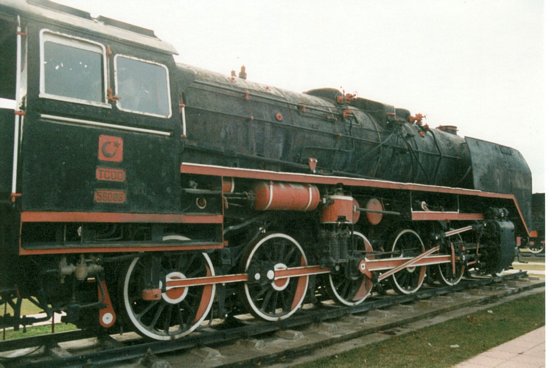|
Assembly of the frame
Axle gauge and general consideration
For some unknown reason, Revell track is 17mm wide, instead of 16,5mm for a HO scale. The axles and the frame are designed accordingly. Therefore, once complete, the loco will not fit an HO track unless this is corrected. All the axles must narrowed by at least 0.5 mm and the frame must be narrowed by about 1mm to allow some lateral movement of the axles.
Next, one must be careful to avoid the curse of the Revell frame: everything is aligned, parallel and square, yet the engine does no sit properly of the track because the frame is twisted! A very careful assembly of the frame is required to avoid this.
The BR41 and the BR50 frames have the same height. The BR41 frame will be used except of the trailing bissel, which is replaced by the fifth axle of the BR50 (see figure A).
In the original kit, the axles must be placed before assembly of the frame. I choose to discard these axles and replace them by straight tubes. The whole frame can therefore be assembled without these axles. Assembly of the wheel is then more difficult but painting is much easier.

Frame cutting, bracing and assembly
In both Revell kits, the frame sides are braced by an horizontal part that extends the full length of the frame. This is not prototypical and can be easily modified by using vertical bracing much like real engines.
The Revell original frame spacer is cut to keep only the front-end part supporting the boiler. I narrowed it to 11mm width. For the bracing, I made 2 vertical pieces from styrene sheets, rectangle shape, again 11mm wide. One is placed near the 2nd axle; another is placed near 4th axle.
The frame sides of the BR41 are cut just after the 4th axle suspension, the rear end is discarded. Do the assembly with the bracing as described above. To ensure correct alignment, the frame sides are temporally secured by screws on a piece of wood. Temporary 3 mm tubes are used as axle to align the axle boxes.
The original air tanks part are discarded and replaced by two pieces of 6mm pipes.
The BR50 frame is cut just before the 5th axle suspension, the front end is discarded. On the remaining rear end, Cut and carve off the Indusi apparatus, be careful to keep the cylinder brake. Adjust the length of the frame to that the spacing between the 4th and the 5th axle is identical to the spacing between the 3rd and the 4th axle. Once perfect, glue the rear of the BR50 to the BR41 frame. It should match nicely.
Assemble the cylinders and place them on the frame. I plugged the square opening underneath the cylinders even though this can hardly be seen.
Assemble also the front-end bissel, adapt the axle again so that the wheels fit a HO track. It is best no to glue the wheels yet.
Finally, the BR41 frame extends a few millimeters to far in front of the cylinders compared to the 56000. The front end of the frame must be shortened by about 3 to 5mm to be of the correct length (sorry I did not record this exact measurement). This will be discussed more in detail below, during assembly of the buffer beam.

Air pump
On the Revel kit, the pump supplied is of a very different type that the Nielebok-Knorr pump actually used on the 56000.
Having no spare Nielebock pumps, I scratch built a "good enough" one. This pump is supported by a beam attached to the frame rather than the walking board. This follows the real 56086 and is both easier and stronger.

56086, Ankara museum
The pump is clearly seen
on this pictures
|